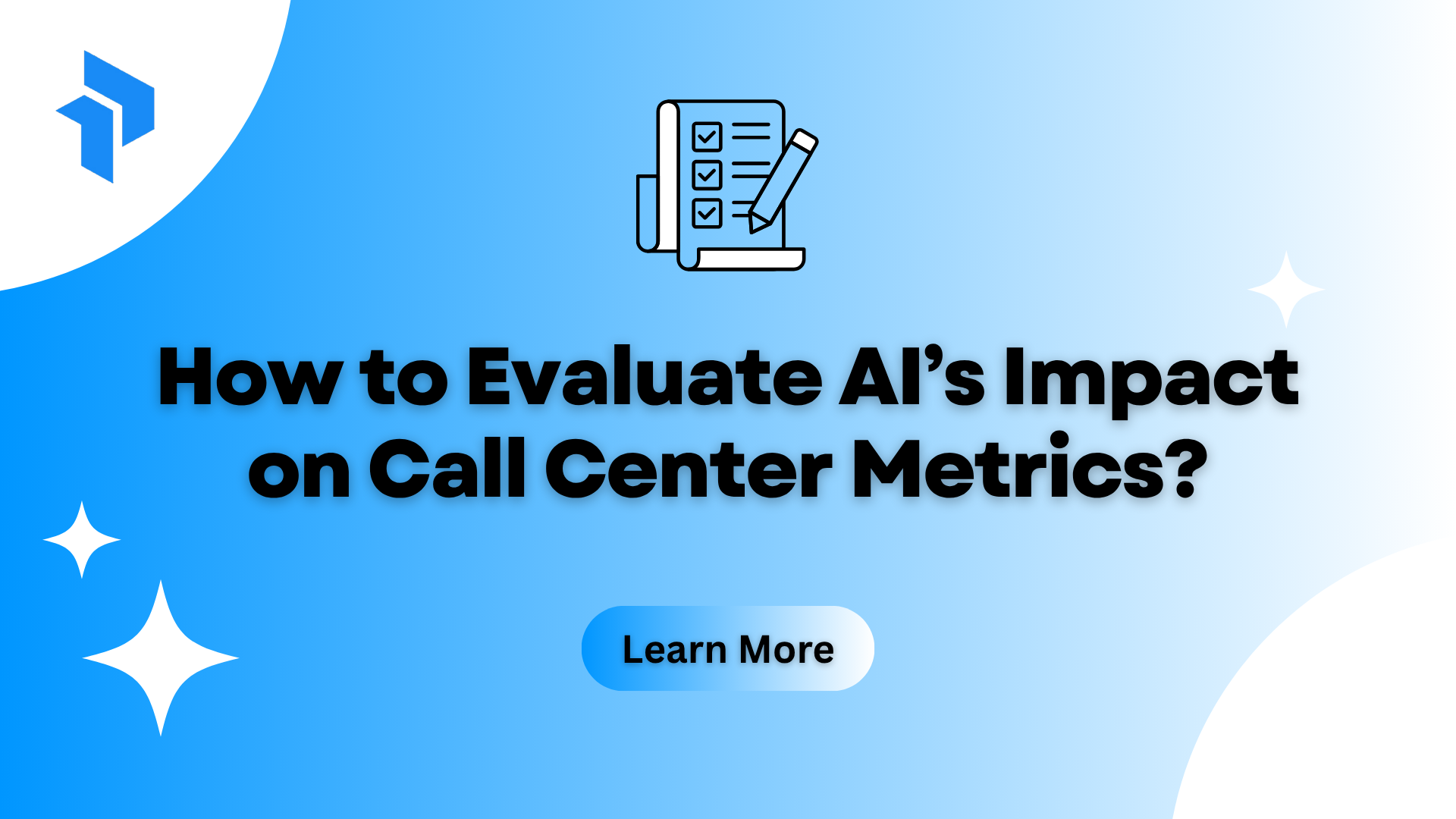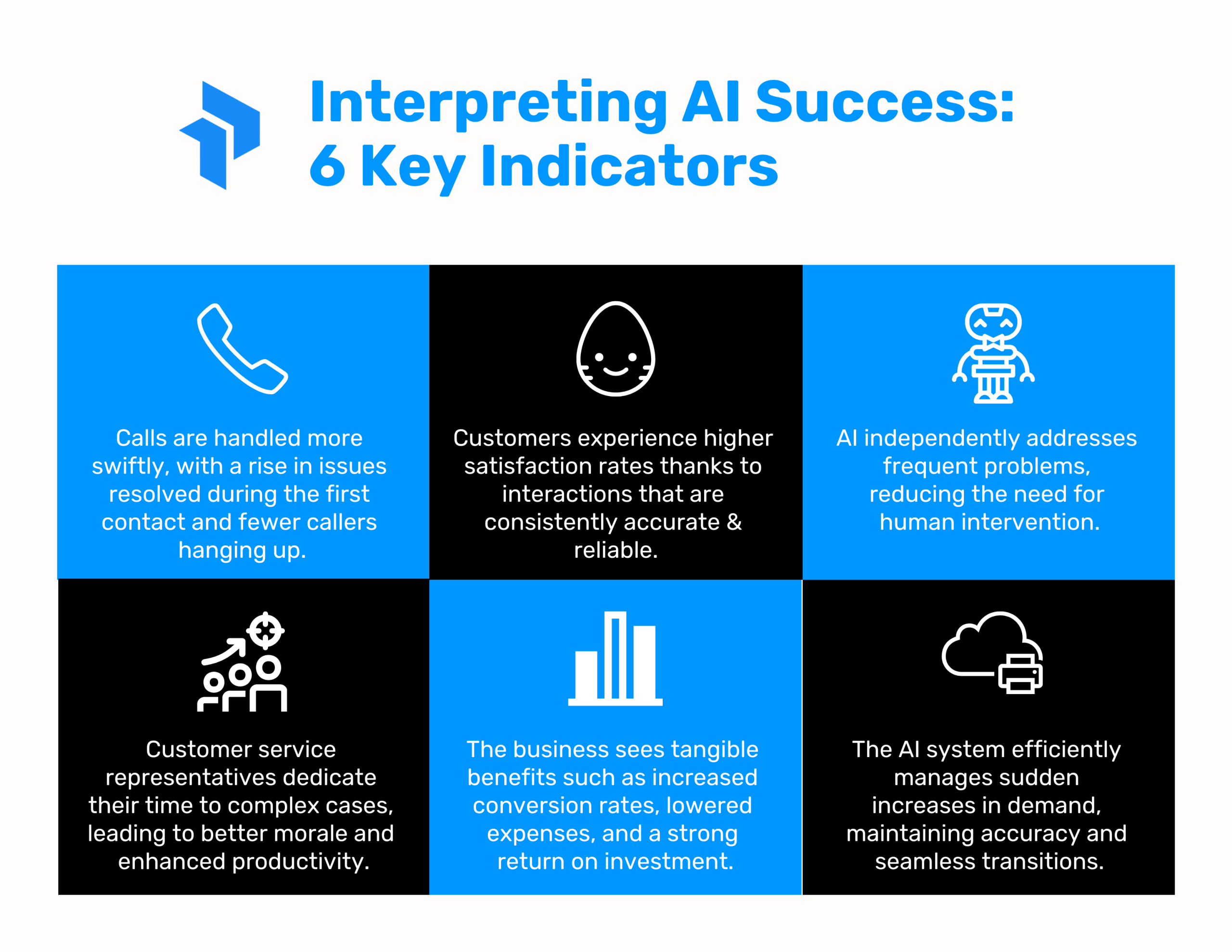
As AI continues to reshape the way call centers function, it’s becoming a vital tool for enhancing efficiency and elevating customer experiences.
However, simply implementing AI solutions isn’t enough to guarantee success. To fully leverage AI’s potential, it’s crucial to measure its performance and understand how it influences important call metrics.
From tracking how quickly calls are handled to gauging customer satisfaction and agent effectiveness, monitoring these indicators is key to optimizing your AI strategy.
This article will guide you through the best practices and critical metrics for assessing AI’s impact in your call center, helping you make data-driven decisions that drive real results.
What Is AI’s Role in Call Centers Today?
1. Streamlining Routine Interactions
- AI-driven virtual assistants and chatbots efficiently manage frequent requests such as checking account details, booking appointments, and resolving simple issues.
- This automation shortens wait times and lessens the burden on live agents.
2. Smart Call Distribution
- AI evaluates the caller’s needs and history to connect them with the most qualified agent quickly.
- This targeted routing boosts the chances of resolving issues on the first call.
3. Monitoring Customer Emotions in Real-Time
- By analyzing voice tone and speech patterns, AI gauges customer mood during calls.
- Alerts can prompt supervisors to step in when conversations risk becoming tense.
4. Personalized Customer Engagement
- AI uses customer data to tailor conversations, delivering more relevant advice and solutions.
- This customization enhances customer satisfaction and loyalty.
5. Insightful Data Analysis
- AI systems gather and interpret call data, tracking agent performance and uncovering trends in customer behavior.
- These insights help optimize workflows and highlight areas needing improvement.
6. Reducing Costs and Improving Efficiency
- Automation of repetitive tasks lowers operational expenses and eases agent workloads.
- This allows agents to dedicate time to handling more complex or sensitive inquiries.
7. Handling Volume Spikes and Providing Constant Support
- AI-powered platforms manage surges in call volume effortlessly and provide 24/7 assistance.
- This ensures reliable service availability without compromising quality.
Why It’s Essential to Measure AI Performance
Evaluating how well AI performs in call centers is crucial to ensure it truly benefits the business.
Without clear performance tracking, companies can’t accurately assess whether AI is enhancing customer experience, driving efficiency, or reducing costs.
1. Proving Value and Guiding Investment
Measuring results helps demonstrate the financial and operational benefits of AI, supporting informed decisions about scaling or adjusting the technology.
2. Pinpointing Improvement Opportunities
Performance data highlights where AI may fall short—such as misunderstandings or poor call routing—enabling targeted enhancements to boost effectiveness.
3. Maintaining Customer Satisfaction
Keeping an eye on customer feedback and resolution rates ensures AI contributes positively to service quality and flags issues early for quick fixes.
4. Streamlining Agent Performance
Analyzing AI’s impact on agent workload and productivity helps optimize the balance between automation and human support.
5. Managing Compliance and Minimizing Risk
Tracking accuracy and fallback occurrences guarantees AI adheres to regulatory requirements and reduces communication errors.
6. Informing Strategic Growth
Insightful metrics empower leadership to refine service strategies and expand AI capabilities with confidence.
Key Call Metrics Influenced by AI (And Ways to Track Them)
Integrating AI into call center operations reshapes several vital performance indicators. Monitoring these metrics is crucial to gauge AI’s true effect on efficiency and customer experience.
1. Average Call Duration
- Definition: The total time spent on a call, including hold and after-call work.
- AI Influence: Automation of repetitive tasks like identity verification and routine inquiries speeds up calls.
- Tracking Method: Analyze call center reporting tools to compare average call lengths before and after AI implementation.
2. First Contact Resolution (FCR)
- Definition: The share of calls resolved without the need for follow-ups.
- AI Influence: AI enhances understanding of customer intent and improves routing, boosting resolution on the initial call.
- Tracking Method: Measure via customer relationship management (CRM) systems and direct customer feedback.
3. Customer Satisfaction (CSAT)
- Definition: Customer ratings of their service experience, often collected through surveys post-interaction.
- AI Influence: Quick, accurate AI responses typically lead to higher satisfaction levels.
- Tracking Method: Gather and analyze survey results and sentiment data tied to AI-assisted interactions.
4. Call Abandonment Percentage
- Definition: The proportion of callers who disconnect before reaching an agent.
- AI Influence: AI-driven virtual assistants reduce wait times, resulting in fewer abandoned calls.
- Tracking Method: Use telephony system metrics to monitor abandonment rates before and after AI adoption.
5. Self-Service Effectiveness
- Definition: The rate at which customer issues are resolved entirely through automated channels.
- AI Influence: Strong AI solutions increase the number of successful self-service interactions.
- Tracking Method: Review automated system logs and AI performance reports to evaluate self-service completions.
6. Agent Efficiency and Workload
- Definition: The degree to which agents utilize their time productively during calls and related tasks.
- AI Influence: By offloading routine inquiries to AI, agents can dedicate more time to complex issues, improving efficiency.
- Tracking Method: Monitor agent activity and performance dashboards for changes in workload and productivity.
7. Conversion Rates in Sales or Upselling
- Definition: The percentage of calls that result in successful sales or customer upgrades.
- AI Influence: AI tools assist by qualifying prospects and providing agents with actionable insights, enhancing conversion success.
- Tracking Method: Track sales outcomes linked to AI interactions through CRM systems and analytics platforms.
Tools and Dashboards to Track AI Performance
Accurately tracking AI’s effectiveness in call centers requires specialized tools and dashboards that gather data, provide real-time insights, and enable detailed analysis.
Using the right technology helps teams monitor key metrics and quickly respond to performance changes.
1. Call Center Analytics Platforms
- These platforms focus on monitoring essential call center metrics such as average handling time, first call resolution, and call abandonment rates.
- They often include features designed to measure interactions handled by AI, providing a comprehensive view of AI’s impact on call operations.
- Customizable dashboards allow visualization of AI-driven metrics alongside traditional call data.
2. AI Conversation and Speech Analytics Tools
- Tools in this category analyze recorded calls using speech recognition and natural language processing to assess AI performance.
- They track how accurately AI understands caller intent, how often AI falls back to human agents, and customer sentiment during interactions.
- These insights help identify areas where AI can be improved for better caller support.
3. Customer Feedback and Survey Systems
- These systems collect customer satisfaction scores and other feedback after calls, providing insight into how AI influences the customer experience.
- Integrating feedback with AI usage data helps link AI’s performance directly to customer happiness.
- Dashboards often enable segmenting results by call type or interaction type for deeper analysis.
4. Business Intelligence (BI) Tools
- BI tools aggregate data from multiple sources—including CRM systems, call analytics, and AI platforms—into unified dashboards.
- They allow creation of custom reports and visualizations to track AI-related trends and support strategic planning.
- Automated alerts can be set up to flag any significant drops in AI performance metrics.
5. Real-Time Monitoring Dashboards
- These dashboards provide live data on AI performance and call center operations, enabling quick responses to any emerging issues.
- Supervisors and managers can monitor call volumes, abandonment rates, and AI accuracy in real-time.
- Drill-down features allow investigation of specific calls or agent performance when necessary.
Interpreting the Data: What Success Looks Like

1. Shorter Call Handling Times
When AI is working well, you’ll notice faster call resolution without sacrificing accuracy. Tasks like authentication, routing, and simple responses should be completed more efficiently.
2. Higher First Call Resolution (FCR)
A good AI solution will help resolve issues on the first try, reducing the need for callbacks. This shows it’s understanding intent and delivering accurate responses.
3. Improved Customer Satisfaction (CSAT)
Whether measured through post-call surveys or sentiment analysis, higher satisfaction means customers are finding AI interactions smooth and helpful.
4. Lower Abandonment Rates
Faster response times from AI reduce wait time frustration, keeping callers on the line and engaged.
5. More Successful Self-Service
As AI takes over repetitive or predictable tasks like checking order status or answering common questions, you’ll see a rise in self-service completions and fewer transfers to agents.
6. More Focused Human Agents
When AI handles basic tasks, agents can focus on more complex or sensitive issues. You should see fewer agent handoffs for routine matters and more impactful human interactions.
7. Agent Satisfaction and Efficiency
Teams that feel supported by AI—not replaced by it—report better morale and productivity. Monitoring internal feedback helps validate this shift.
8. Stronger Conversion Performance (for sales AI)
For outbound or upsell calls, well-tuned AI should contribute to qualified leads or even closed deals, showing it’s effective in persuasive conversations.
9. Visible ROI and Cost Efficiency
Over time, AI should help lower operational costs by reducing agent workload, minimizing training needs, and cutting down on errors.
10. Stable Scalability
A major success signal is the AI’s ability to manage higher volumes without increasing cost or dropping in performance quality.
11. Reliable, Accurate AI Responses
When your AI consistently understands callers and responds correctly—with high NLP confidence scores and low error rates—it means your system is reliable.
Smooth handoffs to human agents when needed further confirm solid design.
Common Pitfalls to Avoid When Evaluating AI Performance
Measuring AI effectiveness in call centers is crucial, but certain missteps can distort your insights or limit the benefits AI can deliver. Knowing these common errors helps maintain accurate assessments and maximizes AI’s value.
1. Relying Only on Numbers
- Focusing exclusively on metrics like call time or abandonment misses the nuances of customer experience, such as tone, satisfaction, and agent interaction quality.
- Overlooking these qualitative aspects can lead to an incomplete understanding of AI’s true impact.
2. Skipping Baseline Comparisons
- Assessing AI outcomes without first capturing data from before implementation makes it hard to gauge actual improvements or setbacks.
- Establishing clear benchmarks is essential to measure AI’s real contribution.
3. Expecting Perfection From AI
- Assuming AI can flawlessly manage every call scenario is unrealistic.
- It’s important to identify AI’s weak points—like handling complicated or emotional conversations—and ensure smooth transitions to human agents when needed.
4. Disregarding Agent Perspectives
- Concentrating solely on customer metrics ignores how AI affects agents’ workload, job satisfaction, and efficiency.
- Failing to incorporate agent feedback can lead to frustration and hinder AI adoption.
5. Treating AI Evaluation as a One-Time Event
- Viewing AI performance measurement as a single checkpoint rather than a continuous process risks missing gradual declines or emerging issues.
- Ongoing monitoring and refinement are key to maintaining AI effectiveness.
6. Keeping Data Sources Separate
- Analyzing AI, call center, and customer feedback data in isolation can create a fragmented picture.
- Integrating these datasets leads to deeper insights and more accurate conclusions.
7. Neglecting Continuous AI Training and Improvement
- Deploying AI without regular updates, retraining, and tuning will limit its potential.
- Consistent model optimization based on real interaction data is vital for long-term success.
Leave a Reply